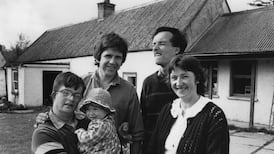You follow a path around a derelict old cottage with rotting thatch, through long grass colonised by briary wild roses, to get to the modern bungalow where Maire Bean Ui Fhatharta lives, on Inis Meain. After raising 11 children in the old house, where she grew up herself, she has in her later years the benefit of a solid-fuel cooker and a television and picture windows that look down on the stony terraces of the island and the encircling sea. But no bungalow will ever be as important as the dark old earth-floored cottage, which is why Bean Ui Fhatharta's daughter Treasa, from her home in London, where she is part of the artistic community, is trying to raise £100,000 or so to mend it. John Millington Synge stayed here, when he came to Inismeain almost a hundred years ago. "Some dreams I have had in this cottage," he wrote in The Aran Islands, "seem to give strength to the opinion that there is a psychic memory attached to certain neighbourhoods . . ." And this plain roadside cottage, under the lea of the great stone cashel of Dun Chonchuir, seems, even in its present decay, to possess the resonance he speaks of. It is a special place.
It was so, even before Synge stepped into its "kitchen, full of beauty and distinction". Treasa Ni Fhatharta has an old photo from a Connradh na Gaeilge booklet of her greatgrandparents standing in the doorway of this cottage. "Oidi na hOllsgoile," the caption says: Professors of the University. It was a "university" of the Irish langage because so many scholars lodged there. In the bedroom - Synge's room - there is still the little wooden pediment where Father Eugene O'Growney, author of Simple lessons in Irish, kept his things for Mass, when he stayed here. Eoin MacNeill was blown out of the Dun, when he tried to camp in his tent there, and he moved in too, and became a friend. Patrick Pearse stayed here, when he visited Aran to set up a branch of the Gaelic League. Synge felt so passionately about the island that in his notebook - not in his published work - he exclaimed, "With this limestone Inishmaan I am in love, and hear with galling jealousy of the various priests and scholars who have lived here before me . . . " Maybe it has pleased his shade, that almost nothing has changed in the cottage since the five years he spent coming and going to it. If he walked in now, pushed back the old wooden door, and went across the ceilingless kitchen to his bedroom, his hearth is the same, his two tiny windows are the same, though now they are choked with ivy, and the family's new bungalow blocks the view of the sea.
De Valera visited, of course. And today, Eamonn O Cuiv has been one of the first to respond enthusiastically to Treasa's plan to ready the cottage for the next part of its destiny. She wants to restore Teach Synge to the state it was in at the turn of the century. She wants to make it into a very simple commemorative centre of Synge himself and the island life of the time. And she wants to make a gable-end room into a place where writers, especially writers connected with Synge, can come and stay. Treasa's grand-uncle taught Synge Irish. Well, Treasa's project would teach Irish people - and anyone else who wants to learn - Synge.
The idea couldn't be more simple. And the end result will be equally simple. There will be no audio-visual presentations or craft shops or heritage experiences. This family cottage, simply, will be returned to the state it was in when the 27-year-old Synge, a genius, walked into its kitchen "to dry the spray from my coat, and several men who had seen me walking up came in to talk to me, usually murmuring on the threshold, `The blessing of God on this place . . . ' "
Treasa hopes to have it done for the centenary of that first visit, which will be next year. And she might pull it off. She has to raise funds to match a pledge from Udaras na Gaeltachta, and so far she has had contributions or promises of support from all kinds of people - Roddy Doyle, Maeve Binchy, Patrick McCabe, Neil Jordan, Professors Nicholas Grene and Declan Kiberd, Albert Reynolds and Jennifer Johnston among them. You can contact Treasa Ni Fhatharta at 74c Mildmay Park, London N1 4PR if you would care to join this list.
I think it a privilege, myself, to be allowed be part of this effort. Mairtin O Direain wrote a poem called "Omos do John Millington Synge" and his translation of it begins,
"The thing that brought you among my people
from rich distance to rough rock
was something in the vital clay,
a trace escaping of woe and loss.
It was not from stone you took your stories,
but the wonders in stories by the fire . . . "
That the hearth Synge sat at should be mended, and the fire lit there again, inside the low thick walls that kept him safe - that seems the perfect way to honour both the man himself and the island society that welcomed him. The cottage was where he encountered the beautiful discourse that he shaped and handed out to the wider world. We wouldn't have had him without it.










